Thunderbird ships for a rp
the base
Tracy Island is situated somewhere in a remote sector of the central Pacific Ocean, midway between Australia and South America. Its precise location is a closely-held secret. Tracy Island appears, to the outside world, as an almost-barren rock.

Formed as a result of seismic shifts in the ocean bed during the late Triassic age, approximately 200 million years ago, the island and its near neighbor, Mateo, are peaks of a sub-aquatic ridge that stretches east across the main tectonic plate to its convergence with the plates. Now completely dormant, both islands were once volcanically active and are internally honeycombed with vast lava-formed chambers linked by a network of extinct vent channels. On the southern side of the island at sea level these form a network of cavernous grottoes, which are reputed to be the home of an elusive species of water mamba. The geological composition of the island's rock strata is also rich in valuable minerals, including sought-after deposits of the ultra-rare Cahelium X.
Following Jeff a purchase of the two islands in the early 2040's of the original Thunderbirds base, work quickly commenced to create an idyllic, self-contained luxury retreat - indicating to the casual visitor Tracy Island was nothing more than a lavish millionaire's paradise, where the family could live a life of luxury oblivious to everyday reality. After construction of an airstrip leading from the northern edge of the island to the cliff-edge of a small plateau, well-placed to catch the dramatic sunsets, work started on a streamlined two-storey villa to Jeff personal design. Built on an outcrop of rock overlooking a palm-fringed apron, which offered the perfect location for a kidney-shaped pool, the villa quickly took shape. Additional accommodation was also planned and constructed to provide guest-quarters and leisure facilities. This consists of the Round House, a cantilevered doughnut-shaped residence built above a sunken circular oriental garden and accessed by a path running to the east of the main house; and the Cliff House, a jutting two-storey construction built into a cleft of rock situated above the landward end of the island's runway and topped with a domed concrete canopy. Internal lift and moving-walkway systems link Cliff House and Villa, with a small hangar entrance built into the base of the cliff. A further internal travel-way connects to a converted ocean-side cave, which acts as a boathouse for the family's various seagoing craft.
Within the Tracy Villa, there is a spacious lounge that forms the focus of the main building, with family bedrooms and a small laboratory workshop on the same floor - all fitted with the latest audio and visual systems, including micro-layer flatscreen TVs and total-surround audio players. There's also a family dining room, a breakfast nook and a modern kitchen fitted with the latest-model atomic cooker.
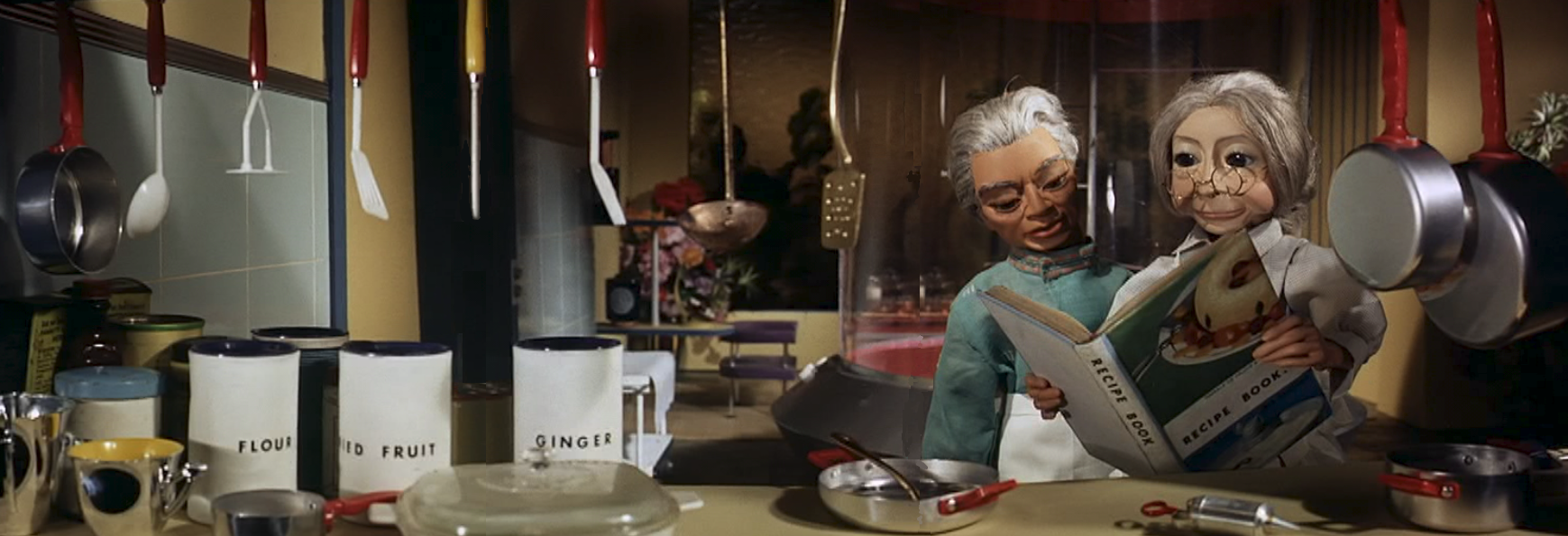

From the lower floor, access can be made to a complex of leisure facilities built into the island's labyrinth of caves. A gym, shooting range, billiard room, a small cinema, a music room and an indoor pool are just a few of the amenities that the Tracy family can enjoy during moments of relaxation. Just off the kitchen is a small tropical patio, with a door leading outside the villa.
The centre of family life, accessed by a smaller reception room leading off a central hallway, the main lounge is spacious and well-lit. Angled French windows along one wall open onto a full-length balcony, from the split-level floor space. Directly facing Kieron and jeff desk, to the left of the room's main entrance, visitors will see portraits of his five children in everyday casual attire.
In the far corner diagonally opposite the main entrance, are kieron and jeff desk and work station. Behind the desk are shelves lined with books and personal mementos, surrounding a video monitor built into a compact electronic control unit and communication post. Originally mounted on twin supports (prior to recent redecoration), the desk could be raised to the ceiling when not in use - but as this proved rarely to be the case, it was replaced with a larger, conventionally supported version. However, this newer model lacked the flip-top feature of the original, which initially housed an electronic keypad and printer.
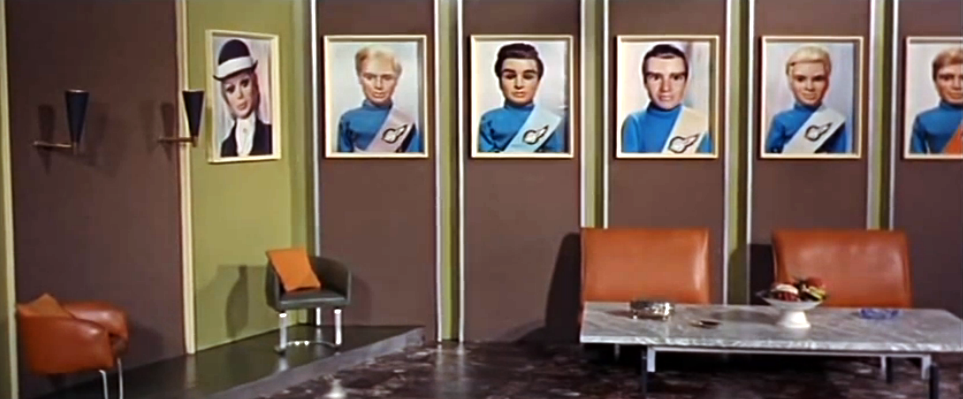

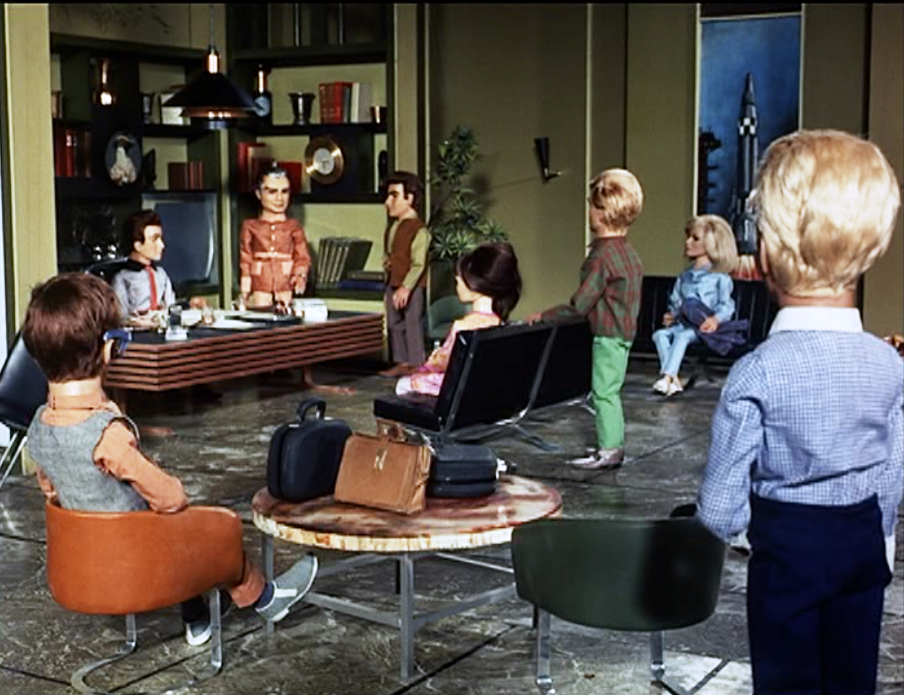
the ships and gear
.
Thunderbird 1
Thunderbird One. The craft has a sharp red nosecone, along with a cylindrical silver body, and a powerful blue engine. It has 4 variable-cycle gas turbine engines; 4 booster rockets; 1 variable-mode engine operating as a high-performance sustainer rocket for launch or boost as a variable-cycle gas turbine in flight. There is even the pitch and yaw jets; 20 forward and 25 rear. It also has a pair of small sweep wings on the sides of the craft, and the cross shaped bottom is positioned in the manner of a plus sign. It is 115ft tall, with a 80ft (35m when the wings are extended) wingspan, and a body diameter of 12ft. It has a definite underside and topside when flying horizontally; the underside has only one VTOL variable-mode jet engine operating as a rocket or variable-cycle gas turbine hover jet, while the topside has "THUNDERBIRD" written down it, completed by the "1" painted on both sides of the blue coloured section. The interior goes from the nosecone to the wings. The pilot's chair is located at the front, near the nosecone, where the windows are. There are no front facing windows, with the aerodynamic nosecone taking up the entire front.

.
Thunderbird 2
The second ship is Thunderbird Two, the workhorse of the fleet. This craft is a green colour scheme, with white writing of its name on either side of the cockpit, and the number '2' on the tail section, and the T2 on the wings. The craft has 2 variable-cycle gas turbine engines operating as turbofans at low speed and supersonic combustion ram jets at high speed, with 12 variable-cycle turbo-ram cruise / trim jets in the tailplane, 4 VTOL turbofan jets in the main body, and 4 VTOL chemical rockets in the landing legs. The ship is 60ft tall (110ft with the pod lowered), while being 250ft long, with a 180ft wingspan. It has an atomic fusion reactor for its power source. Thunderbird 2 is comprised of two parts: a framed superstructure and a pod. Thunderbird 2's frame incorporates the cockpit, wings, and fuel tank near the vehicle's front, and at the rear the engines and the tailplane, which serves to aid lift and stability. Two stilts are located each at the front and back of the craft to hydraulically lift the craft upward, allowing for the clearing of the pod. Its middle is hollow, to fully accommodate one of the six pods that is required for the mission. Each pod is equipped with undercarriage for a smooth landing for the ship, and contains a huge capacity for storing the rescue vehicle that is needed. The craft is, however, completely capable of vertical takeoff and landing without the pod, but has less integrity this way.
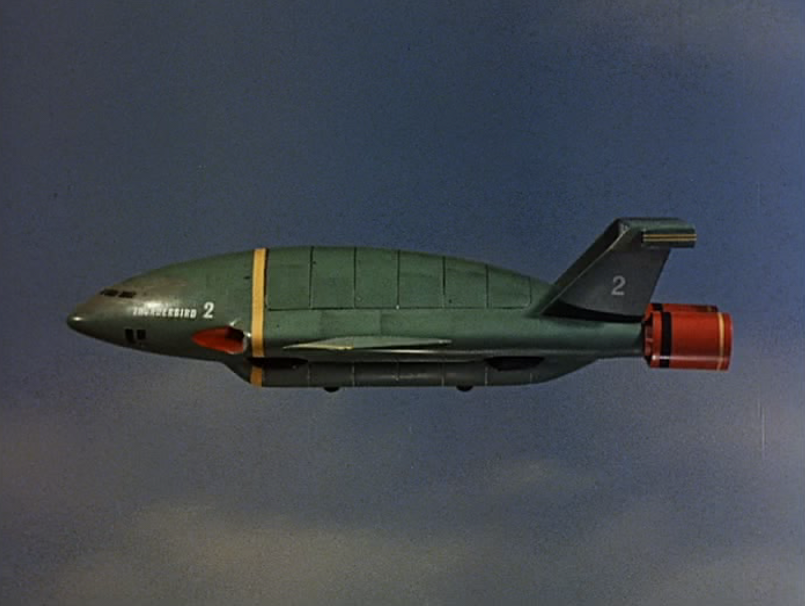
.
The third vessel is the rocket ship, Thunderbird Three. This rocket is 287ft tall, with a body diameter of 70ft, with a wingspan of 70ft, the nacelle span of 80ft, while having a maximum acceleration of 10Gs (over 30,000mph). The drive system is an Ion-drive particle accelerator, with a hybrid electromagnetic/rocket motor. The vessel is in bright red with a white 'THUNDERBIRD' leading back to the dark grey fan-like structure in the middle of the vessel, with three arm-like protrusions on either side of the craft's body, which link up with the three-engine rounded base of the rocket, the number 3 in white on the base. The cockpit is located in the upper-middle of the rocket's body and it has 4 seats. This rocket has Engines: 3 chemical rocket boosters used for launch, landing, emergency boost, and orbit change, with 3 ion-drive particle accelerators used in deep space, along with pitch and yaw rockets. There are 12 boosters in middle ring for course corrections, 20 in the nose and 24 at the rear for attitude adjustments. The rocket has an atomic fusion reactor, an emergency acceleration of 10Gs, with a launch thrust of 4.5 million pounds, a max sustained acceleration of 6Gs, and standard acceleration of G1s.

.
Finally, there is the small yellow submersible known as Thunderbird Four. This small submarine seems to be like a small pocket rocket with a small tailfin on the back of the craft with the rear engines on either side of the craft, and on the front of the sub is a light bar. The craft is 30ft long, with an 11ft width, and weighing 16 tonnes. Is has 4 vertical-thrust hover jets, and 2 x 25 liquid fuel mini-rockets. Is has 6 electrically driven reversible axial-flow turbine impellers for forward and reverse drive. The main turbo drive is 2 axial-flow turbines, providing forward thrust only. It's power source are twin atomic fusion reactors. It's surface cruising speed is 40 knots, with an underwater speed of 160 knots, an emergency launch speed of 30mph. The maximum speed underwater is 160 knots, with a max operating depth of 30,000ft below sea level.
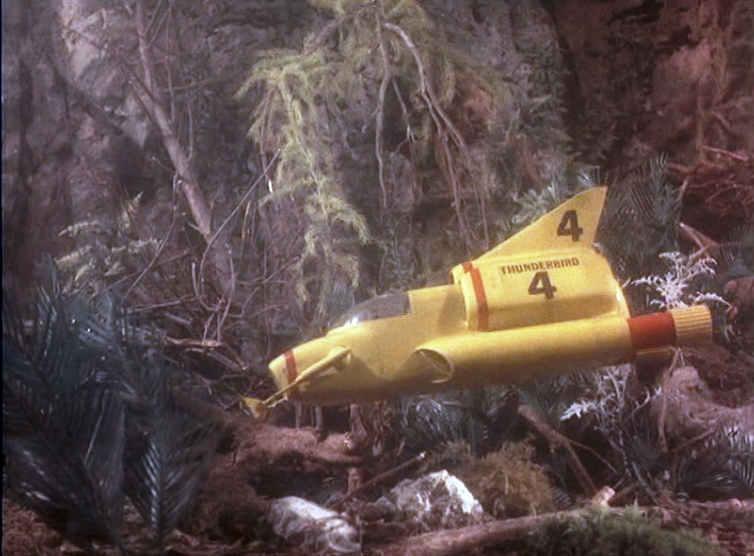
.
Thunderbird 5

.
Rescue vehicles
The Excavator is a specialised digging operations machine utilised for mine or cave collapses. The vehicle is 68ft long, 25ft wide, and weighing 26 tonnes, while powered by an 800bhp high-compression engine. The Excavator has caterpillar tracks, so it can travel easily and smoothly over the toughest of terrains. It is equipped with a powerful precision drill in the scoop, containing the rock crushers that can cut through extremely tough rock and metal. The Excavator's precision drill is made from Formula C30/1 Cahelium alloy. The rock cutter spins forward, scraping rock pieces into the scoop where they are crushed. The crushed rock and dust goes through some ducts and out two extraction nozzles at the rear of the vehicle.
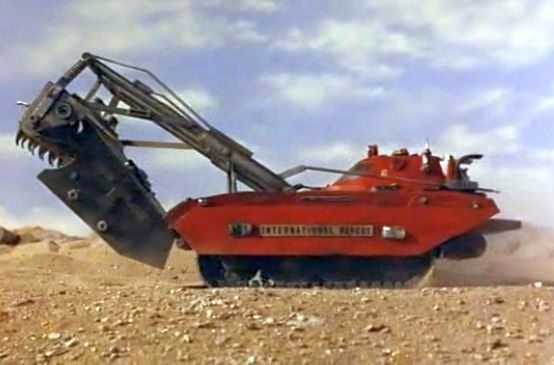
.
The DOMO (Demolition and Object Moving Operator) is a pod vehicle used by International Rescue to lift objects that weigh up to fifty tons.
It's also used to hold up structures in danger of collapsing, as it does in The Duchess Assignment (see more, below).
After the DOMO has secured dangerous buildings from collapse, and/or removed any heavy objects from the danger zone, Firefly and the Mole can then move in to help complete the rescue. These three machines are often used in conjunction with one another.
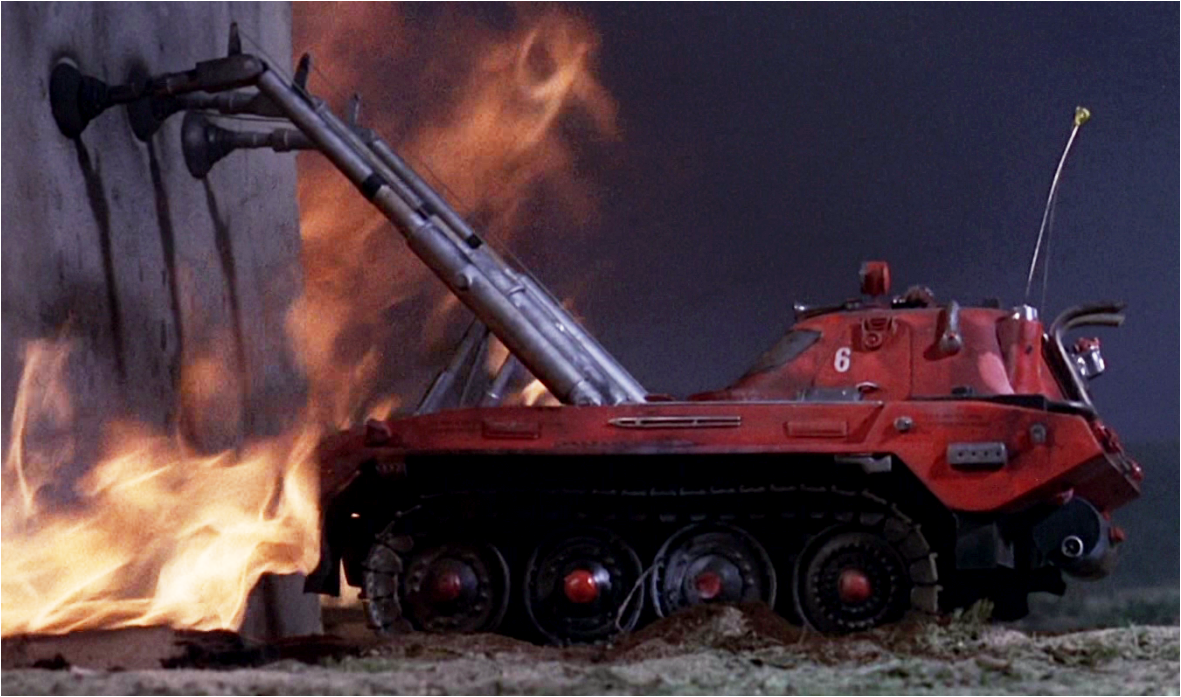
.
The Mole is a medium-sized tunneling vehicle used for underground rescue missions. It is 60ft long, with a width of 12ft, weighing in at 12 tonnes. It has a maximum drilling speed of 15mph, while powered by a nuclear-fusion powered electric motors, along with a 1000bhp Rocket Propellant. An additional set of caterpillar tracks on either side of the vehicle allows it to return to the surface independently, for retrieval. It's equipped with a thermal-imaging system, inside the drill-bit, to locate buried individuals. It is transported to the drilling location by a trolley with caterpillar tracks, so it can travel on rough terrain. A lifting ramp then tips it into position to commence drilling. The trolley is 38ft long, 24ft wide, and weighing 18 tonnes. It's top speed is 50mph on a flat surface, while powered by a 1,000bhp high-compression dual-turbine engine.
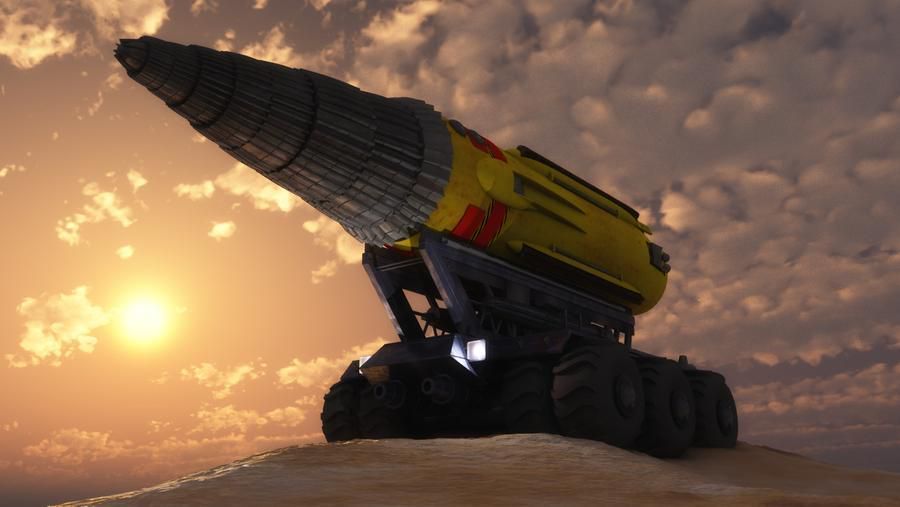
.
The Firefly. It is a dual-purpose fire-fighting and debris-clearance vehicle. The vehicle is 150ft long, with a body width of 30ft, the front shield and dozer blade being 60ft and mounted on hydraulic arms, so it can be raised or lowered. It's has a compact 800bhp power plant, and weighs 56 tonnes. the craft runs on heavily modified fireproof tank treads. The Firefly's forward-mounted shield is constructed of Cahelium Extract-X, providing heat protection from intense temperatures and resilient dozer-blade capability. The shield allows access for the barrel of a heavy-duty gun armed with nitroglycerine shells. These can snuff out otherwise-uncontrollable fires, and for major debris clearance. Rear-mounted water and foam dispensers can be used for vehicle-cooling purposes, and for blaze control.

.
The Recovery Vehicles are two powerful pulling machines that fire magnetic grapples capable of pulling heavy weights, such as planes or trains, out of places like pits or rivers. One of them is manned, the other remote controlled. Each clamp is capable of hauling a maximum weight of 75 tons and have a Cable Length of 800 feet and it has a Length of 50 feet, Weight of 40 tons
A master recovery vehicle and remote subsidiary can be co-ordinated as a pair, to fire clamp-tipped lances connected to 800-foot hawsers at an imperilled vehicle or hazardous structure in order to drag it from a dangerous position. The clamps are launched by powerful compressed-air cannons and are electro magnetic, capable of hauling weights up to 75 tons.
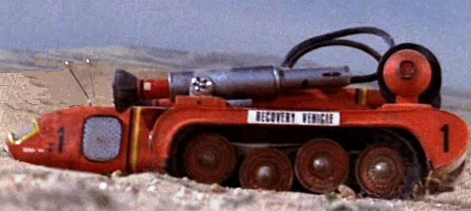
.
Monobrake
The Monobrake is a low-slung search and recovery utility vehicle capable of either travelling along monorail tunnels or, by using its front-mounted cahelium strengthened telescopic arm. The telescopic arm can be attached to an overhead monorail. A safety hood behind the driver/passenger seating serves as a barrier from the extreme temperatures of the jet engine.
Due to its low height, the Monobrake can drive in a monorail tunnel and have a train pass over it without incident.
Length of 14 metres, a Weight of 3 tonnes and a Width of 5 metres

.
Laser Cutter Vehicle
The craft is called the Laser Cutter Vehicle. It is a small vehicle that has caterpillar tracks for smooth movement over rough terrain. It's 7ft 3" tall, 14ft long, 5ft 6" wide. It's power source is a 300bhp high-compression power turbine engine, and it can go up to 65 kilometres per hour. The laser cutter is a long barrel cannon, reaching up to 20ft long.

.
weapons
International Rescue's Standard-Issue Handgun
Probably the best-known hand-held weapon in IR's inventory is this one, which the Tracy brothers always carry when they're "on call" and, as such, is worn in a holster with their uniforms. (This includes space-monitor duty up on Thunderbird 5)
It's a versatile weapon, with three different color-coded cartridges (red, yellow and blue) available depending on whatever a given situation may demand - one is always fitted for immediate use, with the other two stored in special pockets on their uniform belts.
Red (the most-often-seen) fires live ammunition; the other two, respectively, carry stun-gas and needle-darts.
the guns

,
Iron man amours
suit of amour warn by the team for rescue or combat it

Bạn đang đọc truyện trên: Truyen247.Pro